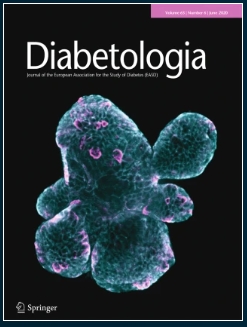Beta cell-specific PAK1 enrichment ameliorates diet-induced glucose intolerance in mice by promoting insulin biogenesis and minimising beta cell apoptosis.
IF 8.4
1区 医学
Q1 ENDOCRINOLOGY & METABOLISM
引用次数: 0
Abstract
AIMS/HYPOTHESIS p21 (CDC42/RAC1) activated kinase 1 (PAK1) is depleted in type 2 diabetic human islets compared with non-diabetic human islets, and acute PAK1 restoration in the islets can restore insulin secretory function ex vivo. We hypothesised that beta cell-specific PAK1 enrichment in vivo can mitigate high-fat-diet (HFD)-induced glucose intolerance by increasing the functional beta cell mass. METHODS Human islets expressing exogenous PAK1 specifically in beta cells were used for bulk RNA-seq. Human EndoC-βH1 cells overexpressing myc-tagged PAK1 were used for chromatin immunoprecipitation (ChIP) and ChIP-sequencing (ChIP-seq). Novel doxycycline-inducible beta cell-specific PAK1-expressing (iβPAK1-Tg) mice were fed a 45% HFD pre-induction for 3 weeks and for a further 3 weeks with or without doxycycline induction. These HFD-fed mice were evaluated for GTT, ITT, 6 h fasting plasma insulin and blood glucose, body composition, islet insulin content and apoptosis. RESULTS Beta cell-specific PAK1 enrichment in type 2 diabetes human islets resulted in decreased beta cell apoptosis and increased insulin content. RNA-seq showed an upregulation of INS gene transcription by PAK1. Using clonal human beta cells, we found that PAK1 protein was localised in the cytoplasm and the nucleus. ChIP studies revealed that nuclear PAK1 enhanced pancreatic and duodenal homeobox1 (PDX1) and neuronal differentiation 1 (NEUROD1) binding to the INS promoter in a glucose-responsive manner. Importantly, the iβPAK1-Tg mice, when challenged with HFD and doxycycline induction displayed enhanced glucose tolerance, increased islet insulin content and reduced beta cell apoptosis when compared with iβPAK1-Tg mice without doxycycline induction. CONCLUSIONS/INTERPRETATION PAK1 plays an unforeseen and beneficial role in beta cells by promoting insulin biogenesis via enhancing the expression of PDX1, NEUROD1 and INS, along with anti-apoptotic effects, that culminate in increased insulin content and beta cell mass in vivo and ameliorate diet-induced glucose intolerance. DATA AVAILABILITY The raw and processed RNA-seq data and ChIP-seq data, which has been made publicly available at Gene Expression Omnibus (GEO) at https://www.ncbi.nlm.nih.gov/geo/ , can be accessed in GSE239382.通过促进胰岛素生物生成和减少β细胞凋亡,富集β细胞特异性 PAK1 可改善饮食诱导的小鼠葡萄糖不耐受症。
目的/假设与非糖尿病人胰岛相比,2型糖尿病人胰岛中的P21(CDC42/RAC1)活化激酶1(PAK1)被耗竭,急性恢复胰岛中的PAK1可恢复体内外的胰岛素分泌功能。我们假设,体内特异性 PAK1 富集可通过增加功能性 beta 细胞的数量来缓解高脂饮食(HFD)诱导的葡萄糖不耐受。过表达 myc 标记 PAK1 的人 EndoC-βH1 细胞用于染色质免疫沉淀(ChIP)和 ChIP 测序(ChIP-seq)。对新型多西环素诱导的β细胞特异性 PAK1 表达(iβPAK1-Tg)小鼠进行为期 3 周的 45% HFD 诱导前喂养,并在使用或不使用多西环素诱导的情况下再喂养 3 周。结果2型糖尿病人胰岛中β细胞特异性PAK1富集导致β细胞凋亡减少和胰岛素含量增加。RNA-seq显示PAK1上调了INS基因的转录。利用克隆人β细胞,我们发现 PAK1 蛋白定位于细胞质和细胞核中。ChIP 研究显示,核 PAK1 以葡萄糖响应的方式增强了胰腺和十二指肠同工酶 1 (PDX1) 和神经元分化 1 (NEUROD1) 与 INS 启动子的结合。重要的是,与未接受强力霉素诱导的 iβPAK1-Tg 小鼠相比,接受高纤维食物和强力霉素诱导的 iβPAK1-Tg 小鼠表现出更强的葡萄糖耐受性,胰岛胰岛素含量增加,β细胞凋亡减少。结论/解释PAK1在β细胞中发挥着不可预见的有益作用,它通过增强PDX1、NEUROD1和INS的表达促进胰岛素的生物生成,并具有抗凋亡作用,最终增加体内胰岛素含量和β细胞质量,改善饮食诱导的葡萄糖不耐受症。数据可用性原始和处理过的 RNA-seq 数据以及 ChIP-seq 数据已在基因表达总库(Gene Expression Omnibus,GEO)中公开,网址为 https://www.ncbi.nlm.nih.gov/geo/ ,可在 GSE239382 中查阅。
本文章由计算机程序翻译,如有差异,请以英文原文为准。
求助全文
约1分钟内获得全文
求助全文
来源期刊

Diabetologia
医学-内分泌学与代谢
CiteScore
18.10
自引率
2.40%
发文量
193
审稿时长
1 months
期刊介绍:
Diabetologia, the authoritative journal dedicated to diabetes research, holds high visibility through society membership, libraries, and social media. As the official journal of the European Association for the Study of Diabetes, it is ranked in the top quartile of the 2019 JCR Impact Factors in the Endocrinology & Metabolism category. The journal boasts dedicated and expert editorial teams committed to supporting authors throughout the peer review process.
 求助内容:
求助内容: 应助结果提醒方式:
应助结果提醒方式:


